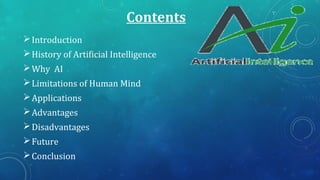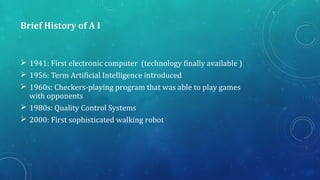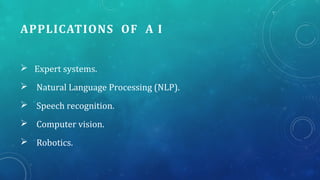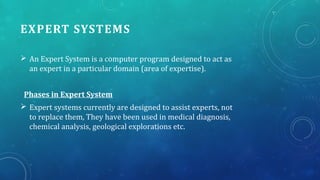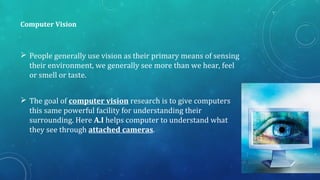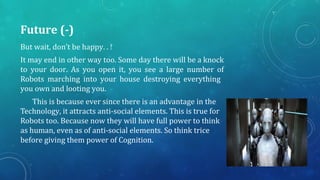ARTIFICIAL INTELLIGENCE.PPT
- 1. WEL COME
- 3. Contents ’āśIntroduction ’āśHistory of Artificial Intelligence ’āśWhy AI ’āśLimitations of Human Mind ’āśApplications ’āśAdvantages ’āśDisadvantages ’āśFuture ’āśConclusion
- 4. Introduction Artificial Intelligence is a branch of Science which deals with helping machines finds solutions to complex problems in a more human-like fashion. This generally involves borrowing characteristics from human intelligence, and applying them as algorithms in a computer friendly way.
- 5. Brief History of A I ’āś 1941: First electronic computer (technology finally available ) ’āś 1956: Term Artificial Intelligence introduced ’āś 1960s: Checkers-playing program that was able to play games with opponents ’āś 1980s: Quality Control Systems ’āś 2000: First sophisticated walking robot
- 6. WHY A I? Computers are fundamentally well suited to performing mechanical computations, using fixed programmed rules. This allows artificial machines to perform simple monotonous tasks efficiently and reliably, which humans are ill-suited to. `
- 7. LIMITATIONS OF HUMAN MIND ’āś Object recognition. People cannot properly explain how they recognize objects. ’āś Face recognition. Cannot be passed on to another person by explanation. ’āś Naming of colours. Based on learning, not on absolute standards.
- 8. APPLICATIONS OF A I ’āś Expert systems. ’āś Natural Language Processing (NLP). ’āś Speech recognition. ’āś Computer vision. ’āś Robotics.
- 9. EXPERT SYSTEMS ’āś An Expert System is a computer program designed to act as an expert in a particular domain (area of expertise). Phases in Expert System ’āś Expert systems currently are designed to assist experts, not to replace them, They have been used in medical diagnosis, chemical analysis, geological explorations etc.
- 10. Natural Language Processing The goal of NLP is to enable people and computers to communicate in a natural (humanly) language(such as, English) rather than in a computer language. The field of NLP is divided in 2 categoriesŌĆö ’āĀ Natural Language understanding. ’āĀ Natural Language generation.
- 11. Speech Recognition ’āś The primary interactive method of communication used by humans is not reading and writing, it is speech. ’āś The goal of speech recognition research is to allow computers to understand human speech. So that they can hear our voices and recognize the words we are speaking. ’āś It simplifies the process of interactive communication between people and computers, thus it advances the goal of NLP.
- 12. Computer Vision ’āś People generally use vision as their primary means of sensing their environment, we generally see more than we hear, feel or smell or taste. ’āś The goal of computer vision research is to give computers this same powerful facility for understanding their surrounding. Here A.I helps computer to understand what they see through attached cameras.
- 13. ROBOTICS A Robot is a electro-mechanical device that can by programmed to perform manual tasks or a reprogrammable multi functional manipulator designed to move materials, parts, tools, or specialized devices through variable programmed motions for performance of variety of tasks. An ŌĆśintelligentŌĆÖ robot includes some kind of sensory apparatus that allows it to respond to change in itŌĆÖs environment
- 14. Advantages ’üĮ They will probably be increasingly used in the field of medicine. ’üĮ A knowledge based expert system, which can cross-reference symptoms and diseases will greatly improve the accuracy of diagnostics. ’üĮ Object recognition will also be a great aid to doctors. ’üĮ Along with images from cats cans or X-ray machines, they will be able to get preliminary analysis of those images. ’üĮ This of course will be possible only if people solve legal questions that arise by giving power to a machine to control or influence the health of a human
- 16. Disadvantages ’āś Self-modifying, when combined with self-replicating, can lead to dangerous, unexpected results, such as a new and frequently mutating computer virus.
- 17. FUTURE (+) The day is not far when you will just sit back in your cozy little beds and just command your personal Robot's to entirely do your ruts . He will be a perfect companion for you. Just enjoy the Technology.
- 18. Future (-) But wait, donŌĆÖt be happy. . ! It may end in other way too. Some day there will be a knock to your door. As you open it, you see a large number of Robots marching into your house destroying everything you own and looting you. This is because ever since there is an advantage in the Technology, it attracts anti-social elements. This is true for Robots too. Because now they will have full power to think as human, even as of anti-social elements. So think trice before giving them power of Cognition.
- 19. Conclusion In itŌĆÖs short existence, AI has increased understanding of the nature of intelligence and provided an impressive array of application in a wide range of areas. It has sharpened understanding of human reasoning, and of the nature of intelligence in general. At the same time, it has revealed the complexity of modeling human reasoning providing new areas and rich challenges for the future.
- 21. Thank you



